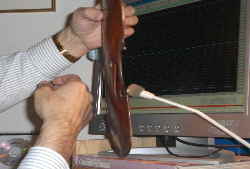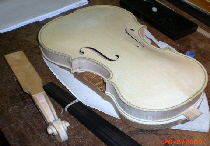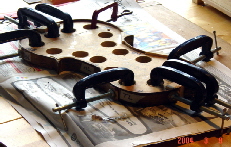|
Experimental violin: this is a lions head scrolled German (transitional *) fiddle, from the early 1800's. Originally it had an intrinsic bassbar - that is carved from the belly wood itself - but it had such a low belly Mode 2 that I experimented by adding 5 cross-braces to bring the belly Mode 2 up, and which also improved the ring/Mode 5 resonance. As an experiment - it has been a great success: it has an outstanding tone, and is a delight to play, being easy to bow, and carries very well: much better than I would have expected with such a low Stiffness Factor.
Here is the spreadsheet that gives the Stiffness Factors of belly and back, which has the same data as shown in Table 1.1 below.
|
Ssheet Lionshead violin SFs V1.0.xls Table 1.1
|
11 Mar '10
|
|
|
|
|
Stiffness Figures are for fully finished plates with varnish
|
|
|
Belly ref. Weight (gms.)
|
64.7
|
Belly Stiffness Figure
|
4,500,000
|
|
|
|
Back ref. weight (gms.)
|
109.3
|
Back Stiffness Figure
|
7,580,000
|
|
|
With 5 cross-braces added to belly. Has a 1-piece slab-cut back.
|
|
|
Weight (gms.)
|
Mode 2 (Hz)
|
Mode 5 (Hz)
|
Stiffness Factor
|
Tone evaluation
|
|
Belly
|
75.5
|
160
|
328
|
0.93
|
V good G and D strings. Outstanding sound.
|
|
Back
|
98
|
181
|
331
|
0.90
|
The neck on this violin was too short by 12 mm, so I lengthened it by adding to the neck root, and put the neck angles right at the same time: it was skewed relative to the body. The pictures below show how the work was done: remember this is not a Strad!
The belly had a very low Mode 2: properly thicknessed it was at 129 Hz, and I want a minimum of 155 Hz. Worse than that though was the poor ring or Mode 5 tone: no where near strong enough. Adding 5 cross braces improved Mode 5 dramatically, and also brought Mode 2 to 160 Hz, adding about 3.5 grams of weight. The cross braces are each just under 2 mm high by 3.5 mm wide. of weight. The cross braces are each just under 2 mm high by 3.5 mm wide.
I think this fiddle shows that getting a high enough Mode 2 to get a ‘octave' plates (Mode 5 = ~2 x Mode 2), can noticeably improve the G and D strings.
William (“Jack”) Fry would have some interesting things to say about the effects of these cross braces, as they will couple vibrations sideways into the belly into some critical areas, having the effect of significant local thickness increases - especially at the ends of the bassbar and just above the ff holes. His lecture (1 1.2 hrs.) is at the website above, and books on “A Physicist's Quest for the Secrets of Stradivari” (with DVDs) are available here, with an article on him and his quest here. Many thanks to Jeff Minniear of Schenectady NY for the links and the article on Jack Fry.
The belly is 2.5 mm in the top and bottom areas, and nearly 3 mm between the ff's. The back is 2.9 mm thick in the upper lung, up to 4.7 at the middle of the back, and 3.0 in the lower lung.
|











